A new report from the Education Policy Institute (EPI) examines the financial health of sixth forms and colleges in England, revealing the extent of the funding squeeze affecting these institutions.
The report, commissioned by Pearson, considers 16-19 education funding, which includes school sixth forms, sixth form colleges and further education colleges.
Funding levels and the quality of provision in sixth forms and colleges can have a huge impact on life chances. They also affect the vast majority of young people: between the age of 16 and 19, three-quarters of all young people attend these institutions. At present, there are a total of 1.4 million students enrolled in England.
This new report provides the most up to date assessment of funding in these institutions, revealing the latest figures for 2018/19. The research explores the impact on different types of institutions and groups of students across the country. It also considers how funding has affected qualifications, teacher wages and the quality of education on offer.
You can download the full report here.
Key findings
Funding trends in sixth forms and colleges
- Between 2010/11 and 2018/19, real terms funding per student in school sixth forms, sixth form colleges, and further education (FE) colleges declined substantially, by 16 per cent, from £5,900 to £4,960. This is twice the rate that the overall schools budget fell by between 2009/10 and 2017/18 (8 per cent).
- Funding in school sixth forms declined by 26 per cent per full time student from 2010/11 to 2018/19. In the further education sector (sixth form colleges and FE colleges), funding declined by 18 per cent per full time student. Within this, funding for sixth form colleges fell faster than in FE colleges.
- Despite funding being shifted towards disadvantaged students over this period, students in all institutions have experienced real terms funding cuts.
- 16-19 education has been the biggest real terms loser of any phase of education since 2010/11, but it has also suffered from a long run squeeze in funding: 30 years ago, 16-19 funding was far higher (almost 1.5 times) than secondary school funding, but is now lower.
- The financial health of 16-19 providers has significantly deteriorated since 2010/11: the proportion of those with in-year deficits has increased across all institutions, with a particularly large rise seen in sixth form colleges: a five-fold increase of 7 to 36 per cent from 2010/2011 to 2016/17.
- An increasing number of local authority schools with sixth forms are in financial difficulty – the proportion with cumulative deficits has risen significantly from 12 per cent of schools in 2010/11 to 22 per cent in 2017/18. In stark contrast, schools without sixth forms have only seen rises of 6 per cent to 9 per cent.
Provision in sixth forms and colleges
- Students in 16-19 education are receiving fewer hours of learning: learning hours with a teacher for students in all institutions fell by 9 per cent between 2012/13 and 2016/17. The deterioration of 16-19 institutions’ finances may exacerbate these trends further.
- This fall in taught hours is particularly prominent in academic subjects: level 3 subjects (A level or equivalent) have seen a sharp decline in hours by 21 per cent between 2012/13 and 2016/17.
- For academic subjects, there has been a large decline in AS provision, which has not been offset by rises in the number of hours elsewhere. This may raise concerns about the curriculum becoming even narrower: upper secondary education in England is already narrow compared to leading education nations in the OECD.
Teacher pay in sixth forms and colleges
- Teacher pay has fallen across 16-19 institutions, but has declined particularly in further education colleges – by 8 per cent from 2010/11 to 2016/17 (from £33,600 to £31,000).
- This means that teacher wages in FE colleges are now around 17 per cent lower than for teachers in secondary schools. This may have implications for the quality of provision, and may adversely affect the most disadvantaged young people, given FE colleges admit a disproportionate number of students from such backgrounds.
Ofsted ratings
- There is no clear relationship between the recent funding squeeze and the Ofsted rating of 16-19 providers. However, it remains the case that the Ofsted ratings of FE colleges, on the whole, are less favourable than for schools.
Policy recommendations
- The government should urgently review the adequacy of 16-19 funding, to understand whether current funding rates are jeopardising the sector’s financial sustainability.
- The government should assess the impact of 16-19 funding changes on curriculum breadth, ensuring that young people have a good choice of high quality post-16 academic and vocational qualifications.
- The government should review the impact of funding changes on disadvantaged students and consider whether funding is supporting the government’s aim of narrowing the attainment gap.
This report has been commissioned by Pearson.



